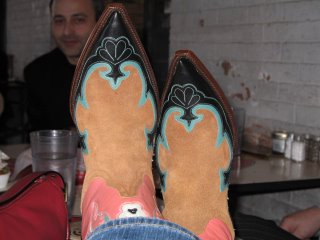Of Northern Italians, Tequila, and Handmade Boots
 High on the list of Things That Keep Me From Flinging Myself Off a Bridge is meeting very handsome Northern Italians who make and sell amazing wine. The Hub was showing these gentlemen around his accounts, and since I'd previously reviewed one of the labels, he invited me along. Despite his initial concern, two of us gals decided that we simply could not miss these guys trying on real Texas cowboy boots, and ended up hanging on the whole night with 'em. Why the hell not? Who doesn't want the companionship of cool, brilliant females?
High on the list of Things That Keep Me From Flinging Myself Off a Bridge is meeting very handsome Northern Italians who make and sell amazing wine. The Hub was showing these gentlemen around his accounts, and since I'd previously reviewed one of the labels, he invited me along. Despite his initial concern, two of us gals decided that we simply could not miss these guys trying on real Texas cowboy boots, and ended up hanging on the whole night with 'em. Why the hell not? Who doesn't want the companionship of cool, brilliant females?Bressan's Wines
Fulvio Luca Bressan, a classically trained Bordeaux winemaker and decended from a family long dedicated to the vines, takes no shit and cuts no corners when it comes to making wine. Like many in Friuli, he's of the opinion that varietals such as Pinot Nero (Noir) and Cabernet Sauvignon do not "belong" to the French, since those varietals have been cultivated by their ancestors since the early nineteenth century. He believes that these grapes have not only a home in Friuli, but can reflect in their quality and terroir that long history, and be among the finest in the world. For him, the fruit and it's pips dictate readiness for harvest, and wood treatment should always reflect subtly in the finished juice. That means big 2,000 liter barrels. "I want to drink the wine, not eat the door to the kitchen," he says.
Fulvio doesn't release his wines until the earliest possible stage of their readiness. At that time they should be lovely and approachable, but will "always taste better for the rest of their lives".
Now that might sound obvious and all, but this man understands what the meaning of "earliest possible stage" is. His current release of Pignolo, a "a pain in the ass" of a grape, is 1997.
1997 Bressan 'Pignol' Pignolo, Friuli
This varietal is native to Friuli, and is another vanishing beauty in Italy. Called 'The Ancient Friulian Nobleman', a good one yields up subtle but complex aromatics and an elegantly restrained palate. I can't think of anything that compares to it. Despite the near decade on this wine, it's still a teenager with vibrant color and ripe fruit. Put your nose half an inch above the rim, you get violets. Deeper in: anise, minerals and crushed dark berries. Tannins...oh, jeez, what did the Hub say? "They massage the feet of the grape..." which led to a long extension of that metaphor across the table for which we ought all to be spanked. Anyway, they were damned supple. And this baby's only going to get better. Fulvio believed that this wine will be at it's peak in twenty-five more years. Maybe an exaggeration, but I was convinced at the time.
2001 Bressan Pinot Nero
I'm gonna break the Cardinal Rule of blogging and admit that I am only just now wrapping my mind around Pinot Noir and all of it's little secrets. But being a novice isn't a bad thing at all: the learning is the real blast, and a good Pinot can require discussion regardless of your degree of know-it-all-ness. It took me many questions answered and many returns to this glass to begin to understand the way it had already developed, and where it was headed. The nose was big with dominant red berry fruit, black tea and minerals, with little of the earthiness that signals a traditional style to me. But this wine is far from mature. It was a pleasure to drink now, especially with it's already remarkably supple tannins, but I learned it would take several more years at least to fully acquire the intensity promised in the palate.
The Bressan estate does several other wines, including a Schiopettino that wasn't available for tasting (dammit). They grow Merlot and Cabernet, as well as several white varietals including Pinot Grigio and Verduzzo.
Casa Zuliani
I fell in love with the Tocai Friulano a while back, and was super stoked to get me some more o' that goooood Friulian white. This is one of the best, and I mean best in that literal way, places on the Lord's earth for white wine. Tell me I'm wrong, c'mon, bring it! I know there's the Loire and Burgundy and the Mosel and wherever, and I'm telling you that Northern Italy is their frickin' peer. Casa Zuliani has been around since 1923, the vines are nestled in a region just between the DOCs of Collio and Isonzo del Friuli. Frederico Frumento, an heir to the estate runs the place now, and mama, is he a good lookin' Italian. (Oh, crap, did I say that out loud?) Er, anyway...a couple of things make his wine so lovely. One is the dirt. The mix of clay and loam under his vines lends a gorgeous minerality, and I understand that particular terroir is exclusive to that little chunk near the Collio. The other thing is that the Zuliani clan's vineyards are managed for very high vine density per hectare (average around 5,000 plants/ha) and very low fruit yield (0.8-1.2 kg).
 2004 Casa Zuliani Malvasia
2004 Casa Zuliani MalvasiaAw, man. Beautiful clear, bright straw yellow. Aromatics full of ripe pit fruit, flowers and herbs. Super crisp, dry and mineral-licious on the palate. It sees six months in stainless and then one more month in bottle. I'd put this up against any shellfish wine you love any day.
2004 Casa Zuliani Sauvignon Blanc
Sauv Blanc from Friuli is like no other expression of it in the world. You can keep your big stinky NZ stuff, no offense. This is also aged in stainless for six and in bottle for one. Have you ever crushed fresh tomato leaf in your fingers? That's what this wine smells like. The palate is as lush as it needs to be, with lots of star fruit and minerals and a long, rich finish. Frederico told me that his estate also makes a select Sauvignon Blanc that doesn't make it across the pond, but that is harvested one berry at a time.
 Warning: do not drink tequila before meeting back up at the most famous boot store in Austin. Your understanding of the value of money will be severely impaired.
Warning: do not drink tequila before meeting back up at the most famous boot store in Austin. Your understanding of the value of money will be severely impaired.2001 Casa Zuliani 'Winter' Rosso (50% Merlot, 25% Cab Sauv, 25% Cab Franc)
Fun Fact: did you know that what they call 'Cabernet Franc' in Friuli is really Carmenere? Wowza.
The varietals for this wine were vinified separately due to their different ripening times, and were likewise aged in different types of barrels. After 14 months, the wine is assembled in stainless and given six months, then bottled unfiltered. Needless to say, it's a big palate full of fat ripe Merlot complimented with the spicy, dusty love of the Cab and the Franc. Er, Carmenere. That's still messing with my mind. It's a well made wine that I think would appeal now to many people who love a rich ripe style, but for me, I'd like to see what it does in several years.
Fun Fact: did you know that what they call 'Cabernet Franc' in Friuli is really Carmenere? Wowza.
The varietals for this wine were vinified separately due to their different ripening times, and were likewise aged in different types of barrels. After 14 months, the wine is assembled in stainless and given six months, then bottled unfiltered. Needless to say, it's a big palate full of fat ripe Merlot complimented with the spicy, dusty love of the Cab and the Franc. Er, Carmenere. That's still messing with my mind. It's a well made wine that I think would appeal now to many people who love a rich ripe style, but for me, I'd like to see what it does in several years.
 Frederico Frumento, Fulvio Luca Bressan, and Paolo Bernardi (President, Vinus Purveyors). All three say that stelvins and synthetics are for pussies, and only corks will do for a well crafted wine.
Frederico Frumento, Fulvio Luca Bressan, and Paolo Bernardi (President, Vinus Purveyors). All three say that stelvins and synthetics are for pussies, and only corks will do for a well crafted wine.I'd also like to give a shout-out to Scott at Vespaio for his hospitality during our post-tequila dinner, during which he brought us out seven styles of risotto, all of which were little bits o' heaven:






3 Comments:
Love the Friulian wines! I had a great Cab Franc I wrote about in my humble blog from Girolamo Dorigo. It was as good as any I've tasted. He pointed out that some of his oldest vines are Carmenere but most recent plantings are Franc. It was so good I've been tasting those $8 Chilean Carmeneres just to see if I can find a good table wine that has the clean spice of the Franc. As far as the italian streak your on, I can't think of a sexier wine streak to be on, lol!
holy shit...those boots are geeeorgeous. and where kin I find some of that Friulian SB?
internet video poker
Post a Comment
<< Home